Current Wind Projections for Kiteboarding
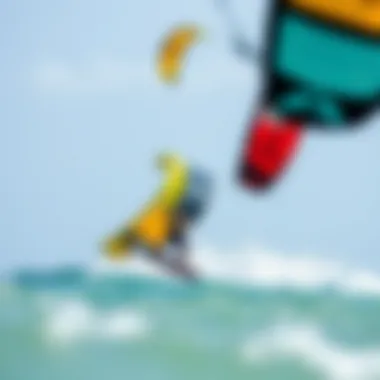
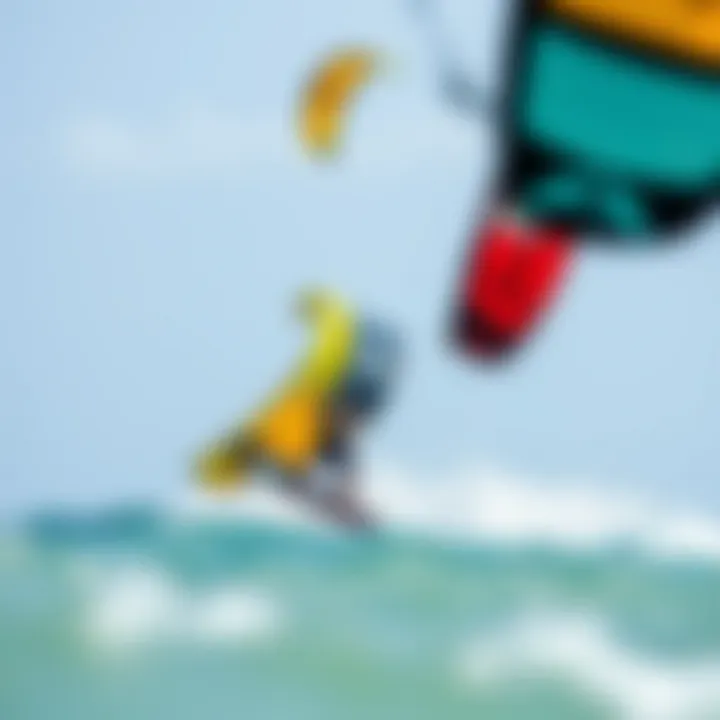
Intro
Kiteboarding is not just about catching waves or performing aerial tricks; it also hinges significantly on understanding wind dynamics. For kiteboarders, wind projections play a pivotal role in shaping the experience on the water. This article delves into the subtleties of current wind projections, catering to kiteboarding enthusiasts eager to enhance their skills and knowledge. By shedding light on various meteorological factors, regional variations, and the tools available for forecasting, you'll gain insights that can transform a mediocre session into a remarkable one.
In the paragraphs to follow, we will cover the essential techniques for both beginners and progressive enthusiasts, offer equipment reviews tailored to the latest innovations in the market, and discuss the significance of wind direction and velocity. With a keen eye on the horizon, let's embark on a thorough exploration of wind conditions that influence kiteboarding, ensuring you're well-equipped for your next gust.
Techniques for Kiteboarding Enthusiasts
Gaining confidence in kiteboarding isn’t merely about embarking on the water; it involves mastering the various techniques tailored to different skill levels.
Beginner Techniques
For those just starting, the focus should be on foundational maneuvers and understanding the wind's behavior. Here are some crucial techniques that every beginner should grasp:
- Kite Control: Learning how to direct the kite smoothly is essential. Keep it low in the wind window for maximum power, and practice shifting it from side to side to feel its pull.
- Body Positioning: Maintaining the correct stance makes a world of difference. Lower your center of gravity and bend at the knees while facing the kite, ensuring balance and stability.
- Launching and Landing: Mastering safe launching and landing practices helps avoid mishaps. Always communicate with your team and establish a clear launch zone.
Advanced Maneuvers
As you gain confidence, it's time to dive deeper into advanced techniques that can take your kiteboarding game up a notch:
- Jumping: Timing your jump with the right wind gust is crucial. Pull the bar in for lift while pushing with your legs to elevate.
- Tricks and Spins: Incorporate spins like the 360 or more complex aerial tricks once you're comfortable in the air. These require precision and planned execution based on wind strength.
- Riding Upwind: Increasing your ability to ride against the wind not only improves control but also sets you up for longer, more thrilling sessions.
Equipment Reviews
The right equipment can significantly affect your performance. In this segment, we’ll evaluate kites and boards that stand out in the current market.
Kite Reviews
In the ever-evolving world of kiteboarding, selecting the perfect kite is paramount. Here are some of the top-rated choices:
- Duotone Evo: Versatility defines this kite. Whether you're racing, freestyling, or simply cruising, it adapts well to varying wind conditions.
- Naish Pivot: This model is renowned for its responsiveness and power. Ideal for wave riders and tricksters alike, it’s a solid investment for the serious kiteboarder.
Board Reviews
Finding a board that complements your abilities is crucial as well. Here are two notable selections:
- Slingshot Misfit: This is a great all-rounder board that excels in diverse conditions. Its build promotes stability and control.
- Liquid Force Rocket: Built for a smooth ride, this board has a unique design that enhances maneuverability and boosts performance.
"Understanding the wind can be as crucial as mastering the board itself. The two go hand in hand, shaping every kiteboarding experience."
Mastering kiteboarding isn't merely about executing one trick after another. A thorough comprehension of the wind and the tools at our disposal makes a significant difference. Looking ahead, kiteboarding enthusiasts can sharpen their skills and enhance their safety on the water by continuously learning about the intricate nature of wind projections.
For more information and to stay updated on the latest in kiteboarding, check resources like Wikipedia's Wind, or engage with communities on Reddit's Kiteboarding Forum. The journey to becoming a seasoned kiteboarder honors a balance of knowledge, skill, and adaptability, meriting a rigorous commitment to understanding the environment around you.
Prolusion to Wind Projections
For kiteboarding enthusiasts, understanding how wind behaves is as crucial as the equipment itself. Wind projections influence your riding experience, from the smoothest glide over the water to how well you can perform tricks. Therefore, grasping the fundamentals of wind patterns and projections provides a solid foundation for anyone looking to enhance their skills or simply enjoy a day on the water.
Navigating the kiteboarding world can feel like trying to catch smoke with your bare hands if you aren’t well-informed about the wind. Knowing how projections work can help you anticipate changes in conditions, optimizing your sessions and minimizing risks.
Understanding Wind Patterns
To appreciate wind projections, one must first dive into wind patterns. These are influenced by a range of factors, including local weather conditions, topography, and even time of year. At its core, wind is air in motion, which can come from various directions and speeds based on how the earth’s surface heats unevenly.


For instance, areas close to large bodies of water often experience unique wind behaviors. In places like the Great Lakes, thermal winds can create an environment where conditions change drastically during the day. You might start with calm waters in the morning, but as the sun rises, the differential heating creates a robust wind by noon.
It’s not just the macro scale that matters. Local features like buildings or cliffs can also disrupt wind flows. Therefore, kiteboarding in small bays might yield wildly different conditions compared to the open ocean. Recognizing these patterns sets the groundwork for making informed decisions.
Relevance of Wind Projections in Kiteboarding
Wind projections play an essential role in kiteboarding. With something as dynamic as wind, having accurate forecasts is key to ensuring safety and achieving optimal performance.
- Safety: Kiteboarding has inherent risks, and poor wind conditions can exacerbate these. Understanding wind projections informs you when conditions may become treacherous, prompting you to stay on shore.
- Performance Enhancement: Adapting your techniques and even your choice of gear based on projections can dramatically improve your time on the water. For example, if forecasts indicate increasing wind speeds, it might be wise to choose a larger kite to maximize lift and control.
- Planning Sessions: Knowledge of where and when the wind will be at its best can help you choose the right kiteboarding hotspot. This is especially relevant for many enthusiasts who travel to find the best conditions.
In summary, having a solid grasp of how wind projections work not only enhances your experience but also acts as a safety net on the unpredictable waters. So whether you’re eyeing a breezy afternoon or planning a weekend trip, keeping tabs on wind projections should be a top priority.
Meteorological Factors Influencing Wind
Understanding the meteorological factors that shape wind is fundamental for kiteboarding enthusiasts. The interplay of various elements such as air pressure, temperature gradients, and geographical features can greatly affect wind conditions, influencing both performance and safety on the water. Recognizing these factors enables kiteboarders to choose the right times and locations for their sessions, ensuring they can harness the wind’s power effectively.
Air Pressure Systems
Air pressure systems are a real driving force behind sustained wind patterns. High and low-pressure systems can dictate where the wind will flow, often creating predictable patterns. In essence, wind travels from areas of higher pressure to regions of lower pressure, resulting in the steadiness that's crucial for kiteboarding. For instance, during summer months, you might notice that a steady breeze develops as a result of high-pressure systems dominating the area.
Moreover, a deep understanding of these systems can enhance your decision-making. For instance, check updates on pressure shifts through meteorological services like the National Weather Service (weather.gov) to choose the best times for hitting the waves.
"Higher air pressure typically means calmer conditions, while lower air pressure brings more winds, ideal for kiteboarding."
Temperature Gradients
Temperature gradients are another piece of the meteorological puzzle. Quite simply, they describe the differences in temperature across various areas. Wind is generated because of these gradients as warmer air rises, and cooler air rushes in to take its place. This movement creates the wind a kiteboarder craves.
Factors like the sun warming the land faster than the sea create notable conditions that kiteboarders can seize. Have you ever noticed how a coastal breeze kicks up in the afternoon? That’s the result of the temperature gradients at work. For those looking to maximize their adventure, being aware of when these changes occur can help you plan your sessions strategically.
Geographical Features
Geographical features have a profound effect on wind conditions. The layout of the land can channel and funnel winds in unique ways. Mountains and valleys, for example, can redirect airflow, creating conditions vastly different from other nearby areas. These topographical influences can result in stronger winds in localized regions, which can be very advantageous.
Consider locations like Maui, where the mountains create what’s known as the "trade winds". This phenomenon is ideal for kiteboarding as it promises consistent, strong wind sessions. To help you navigate these geographical anomalies, familiarizing yourself with wind maps and local topography can set you apart from the crowd.
In summary, understanding how air pressure systems, temperature gradients, and geographical features can influence wind patterns is vital for kiteboarding enthusiasts. This knowledge paves the way for better preparation, ensuring that your time on the water is nothing short of exhilarating.
Current Wind Projections Overview
Understanding wind projections is crucial for kiteboarding enthusiasts who want to make the most of their time on the water. Knowing not just how much wind is blowing, but also from where it’s coming, directly impacts kite choice and positioning on the board. The wind isn't just a side note; it's the very force that propels kiteboarders through their adventures. Accurate projections help in planning trips, ensuring safety, and ultimately enhancing the overall experience.
Data Sources for Wind Forecasting
Several data sources provide the foundation for wind forecasting and projections. Kiteboarders rely on these resources to access real-time information along with historic data to make informed decisions.
- Weather services: National Meteorological Services like NOAA in the United States offer comprehensive wind data. These governmental institutions generally employ robust measurement tools and sophisticated models to provide reliable forecasts.
- Online Weather Platforms: Websites such as Windy.com or WindGuru aggregate data from multiple sources, allowing users to visualize wind patterns across different regions.
- Mobile Applications: Smartphone apps such as Kitesurfing Wind or LiveWeather give real-time updates, which can be a game changer when planning a last-minute kiteboarding session. They usually draw from various sources, including weather stations and satellite data.
"The difference between a great day and a mediocre one on the water can often come down to the details provided by these data sources."
Software and Tools for Wind Analysis
Beyond the data sources, kiteboarders can further elevate their experience using specialized software and tools for wind analysis. These can provide deeper insights and more nuanced forecasts:
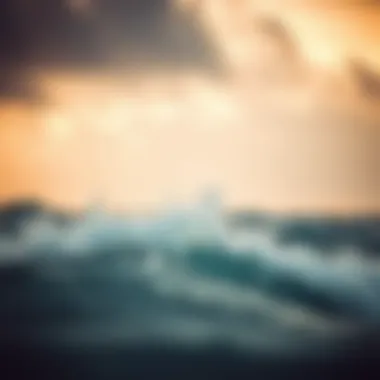
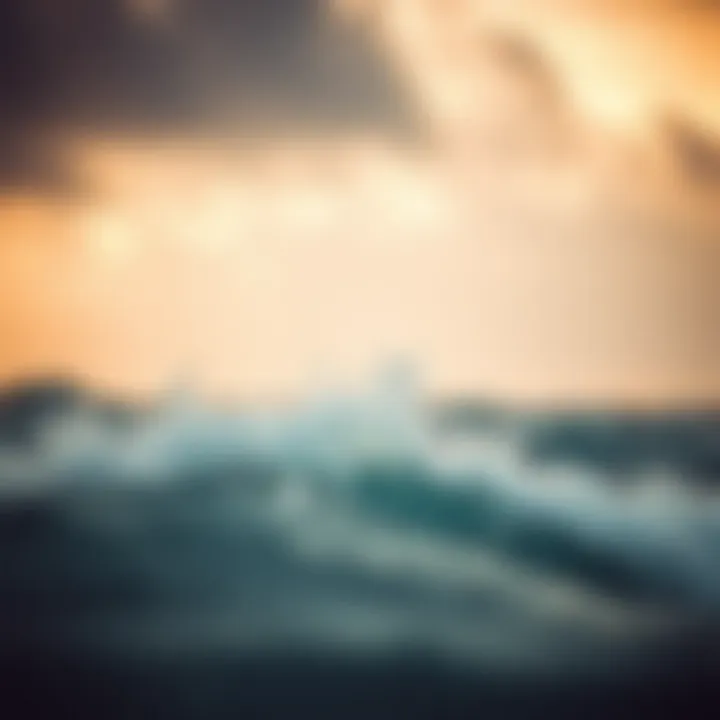
- Simulation Software: Some advanced tools allow users to simulate wind patterns based on geographical data. For instance, tools like OpenFOAM can be employed for computational flow modeling. It may be more technical but pays off for those serious about understanding their environment better.
- Graphing Tools: Using software like Excel or Google Sheets, kiteboarders can plot wind speed and direction over time. This helps to identify trends and make better forecasts based on the data they’ve collected.
- Community Forums: Websites like Reddit often have threads dedicated to wind trends and forecasts, where community members share insights and experiences.
Utilizing a combination of these data sources and specialized tools can significantly impact kiteboarding outcomes. The wind conditions will continue to evolve, and staying ahead of the game means having the right information and tools at your fingertips.
Regional Wind Conditions Today
Understanding the regional wind conditions is essential for kiteboarding enthusiasts looking to make the most out of their time on the water. Different geographical locations have varying wind patterns that can affect not only kite performance but also safety. Knowledge of these conditions enables kiteboarders to select appropriate equipment and techniques, thus maximizing both enjoyment and minimizing risks.
Primary Kiteboarding Hotspots
Many kiteboarders flock to specific locations known for their favorable wind conditions. These hotspots, known globally among enthusiasts, each present unique characteristics. Here are a few standout locations:
- Tarifa, Spain: Often synonymous with kiteboarding, this region boasts consistent winds that attract riders year-round. The Mediterranean and Atlantic meet here, creating diverse wind conditions.
- Hookipa Beach, Maui: Renowned for its clean, steady trade winds, this spot is ideal for both beginners and more experienced kiteboarders seeking challenge.
- The Great Barrier Reef, Australia: Apart from its stunning views, the prevailing winds here often create ideal kiteboarding sessions, especially during certain seasons.
- Le Morne, Mauritius: Known for its exceptional flat-water areas due to its lagoon, Le Morne also benefits from strong winds, making it a kiteboarding paradise.
These locations not only have consistent winds but also offer local knowledge and infrastructure suited for kiteboarding, enhancing the overall experience for riders.
Comparative Analysis of Locations
When it comes time to choose a spot for kiteboarding, one must consider various factors that can influence the experience. Below is a brief comparative look at some popular kiteboarding locations:
- Wind Consistency: Tarifa shines with its year-round winds driven by geographic conditions, while Maui may have slightly more variability depending on the season.
- User Experience: Locations like Hookipa Beach host kite festivals, allowing kiteboarders to network and learn from one another. In contrast, some more isolated areas may not offer this sense of community.
- Local Climate: The tropical climate of the Great Barrier Reef lends itself to warm water sessions, but one must still be wary of seasonal storms, while Tarifa has cooler temperatures but stable wind flow.
- Safety Measures: Kiteboarding at Le Morne can sometimes present challenges due to rocky areas, unlike smoother spots such as Hookipa Beach which might be safer for beginners.
Ultimately, the choice of location can have a significant impact on the kiteboarding experience. By carefully analyzing these factors against personal skill levels and preferences, kiteboarders can ensure that they pick the right spot for enjoyable and safe riding.
Understanding regional wind conditions can dramatically enhance both performance and safety. Say no to blind rides!
Best Practices for Interpreting Wind Readings
Understanding wind readings is crucial for kiteboarding enthusiasts, whether you’re a seasoned pro or just starting out. Getting a grasp on these numbers can mean the difference between a great day on the water and a potentially dangerous situation. Knowing how to interpret wind speed and direction, as well as wind gusts, empowers kiteboarders to make informed decisions that ensure both safety and an enjoyable experience.
By following best practices in interpreting wind readings, you position yourself for success. This knowledge not only enhances your skills but also fosters a greater appreciation for the natural forces at play, making your kiteboarding endeavors all the more rewarding.
Decoding Wind Speed and Direction
Wind speed is often measured in knots or miles per hour, and for kiteboarding, even slight variations can significantly impact your ride. Strong winds can lift you higher but also pose risks if not managed well. Check local forecasts frequently and refer to reliable resources like NOAA.gov to get accurate, real-time data.
- Determine the sweet spot: Most kiteboarding is best done in winds ranging from 10 to 25 knots, depending on skill level. Learning the ideal conditions for your particular kite is fundamental.
- Use a wind meter: A handheld anemometer allows you to capture accurate readings. This small device provides instant feedback on wind conditions, which can help you adapt your kite size accordingly.
- Wind direction matters: Learning to interpret wind arrows on forecasts indicates not just the wind's speed but also its direction. A crossshore wind (coming parallel to the shore) is generally safe, while offshore winds can be dangerous as they may blow you away from the land.
Understanding these elements allows kiteboarders to make necessary adjustments, ensuring a safer and more enjoyable ride.
Understanding Wind Gusts
Wind gusts are brief surges of higher wind speeds. These fluctuations can often catch you off guard. Knowing how to read gusts can save you from precarious situations.
- Anticipate changes: If you notice the forecasts indicating higher gusts than the sustained wind speed, it's wise to choose a smaller kite or prepare for abrupt steering adjustments.
- Assess your own ability: Gusty wind conditions require heightened focus and skill. If you are relatively new to kiteboarding, it might be worth waiting for steadier winds to build confidence and experience.
- Safety first: Avoid overextending yourself. If the winds become unpredictable, it's better to err on the side of caution and either take a break or head back to shore.
"It's about riding the wind's rhythm; knowing when to push and when to pull back can be the difference between a thrilling ride and a tumble into the deep blue."
By embracing these practices and keeping abreast of wind dynamics, kiteboarding enthusiasts can elevate their performance and safety on the water. Whether you're carving up the waves in Cabarete or gliding along the beaches of Cape Town, being savvy about wind readings will lead to more memorable sessions.
Implications of Wind Projections for Kiteboarding
Navigating the expansive waters with a kite in tow isn’t merely about having the right gear. The implications of wind projections hold the key to successful kiteboarding sessions. For enthusiasts and instructors alike, understanding these projections goes beyond knowing whether it might rain or shine. They offer insight into the dynamic relationships between wind patterns, kite performance, and safety on the water. As kiteboarders, being informed about the nuances of wind projections can not only enhance performance but also prevent accidents that stem from sudden changes in wind conditions.
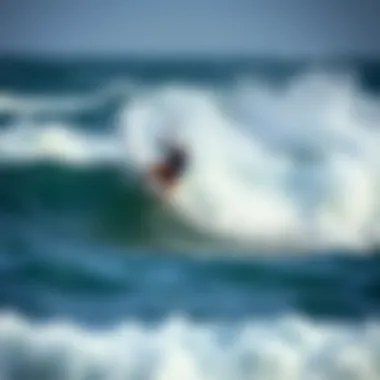
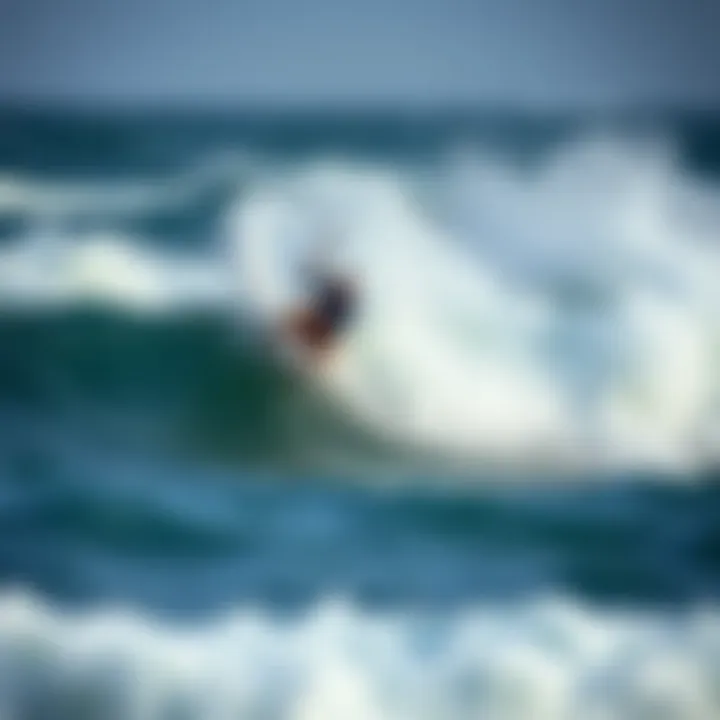
To put it simply, when one is aware of the projected wind speeds and directions, it allows for a well-informed choice—whether to hit the waves or stay ashore. Here are several critical elements to grasp:
- Optimal Performance: Different kites soar best under specific wind speeds and directions. For instance, a light wind day might favor smaller kites, while strong gusts might require a more robust option. An informed kite choice can turn a mediocre session into an exhilarating ride.
- Risk Management: Wind conditions can shift swiftly, and understanding projections helps in assessing risks. Being able to identify when conditions are becoming unsafe allows for timely decisions to improve safety, which is paramount when engaging in such a vigorous water sport.
- Plan Your Session: Whether you're a pro guiding students or a novice learning the ropes, wind projections help in planning sessions that fit everyone’s abilities and expectations. Having this foresight fosters a supportive environment, ideal for both learning and enjoyment.
"Knowledge is power, especially when it comes to wind. Without it, you're sailing blind."
Optimizing Kite Selection
Selecting the right kite hinges directly on understanding the wind’s behavior during your session. Different kites are designed to perform best at specific wind speeds. For example, a kite made for high winds is less suited for a gentle breeze, and vice versa. Here’s how to optimize kite selection based on wind projections:
- Identify Wind Speeds: Begin by gauging the projected wind speed for your location. Most forecasting platforms provide a range of speeds, from light to strong winds. Utilize resources like Windy (windy.com) to check conditions.
- Choose the Right Size: Given the wind conditions, size down or size up your kite accordingly. Here’s a quick reference: for wind speeds ranging from 12 to 18 mph, a medium-sized kite is generally ideal. For speeds above 20 mph, lean toward a smaller kite to improve control and reduce the risk of being overpowered.
- Adjusting for Skill Level: Novice kiteboarders might do well with larger kites, which provide easier lift and control, while advanced riders can use smaller kites that maneuver under stronger winds, allowing for tricks and precision.
Safety Considerations on the Water
Being savvy about wind projections not only enhances performance; it’s also crucial for one’s safety. The unpredictable nature of winds makes it imperative to follow certain best practices:
- Continually Monitor Changes: During your outing, keep an eye on any nuances in wind direction and speed. Conditions can transform from mild to wild in the blink of an eye. Using apps like KiteMate can provide real-time updates on conditions while you're out.
- Recognize Warning Signs: Understand the signs of changing weather. If you notice dark clouds gathering or feel an increase in wind intensity, it may be time to make an exit. It’s better to surf another day than to test your luck with unpredictable weather.
- Check Gear Regularly: Finally, assess your equipment before hitting the water. Ensure your kite is in top shape with no repairs overdue. The last thing you want is a malfunction due to wear on a day with unpredictable winds.
Future Trends in Wind Forecasting
In the ever-evolving world of kiteboarding, understanding future trends in wind forecasting is not just a luxury; it's a necessity. Kiteboarding enthusiasts must grasp how these trends impact their experiences on the water. As kiteboarding heavily relies on wind conditions, advancements in wind forecasting technology and understanding climate dynamics can make a significant difference in both performance and safety. Getting clued in on these developments can be the edge that kiteboarders need, especially in our fast-paced environment where even minor shifts in wind conditions can alter a session dramatically.
Technological Advances in Meteorology
The technological landscape of meteorology has witnessed a seismic shift in recent years, casting a spotlight on how kiteboarders can benefit from cutting-edge tools. One notable advancement is the integration of machine learning into weather models. By analyzing vast amounts of historical data, these models learn to improve their predictions, offering insights that are increasingly precise. For those chasing the perfect wind, this means more informed decisions for planning kiteboarding outings.
Moreover, real-time weather apps like Windy and PredictWind provide live updates on wind conditions across various regions. With detailed radar imagery and forecast maps, these platforms equip kiteboarders with essential data at their fingertips. The importance of wind speed, gusts, and direction becomes even clearer with capabilities such as animated visualization, allowing for quick comprehension of potential wind shifts.
"The latest advancements in forecasting technology equip water sports enthusiasts with tools that can elevate their performances and enhance safety on the water."
Additionally, drones are being deployed for wind measurements in hard-to-reach areas. With the ability to collect data on atmospheric conditions much faster than traditional methods, they help create a comprehensive understanding of local wind nuances and patterns.
Impact of Climate Change on Wind Patterns
Climate change poses serious questions about future wind patterns. This phenomenon isn't just an abstract concern; it’s shaping the wind conditions that kiteboarders depend on. Changes in temperature distributions and ocean currents are already leading to altered wind flows. For instance, as polar ice melts and ocean temperatures rise, the way air circulates is consequently affected, which can result in winds that are less predictable.
In addition, regions that were once considered ideal for kiteboarding might experience a shift in wind reliability and intensity. This means that kiteboarders must stay abreast of these trends to adapt their locations and equipment accordingly. Locations that don’t typically exhibit strong winds may begin to attract more enthusiasts if conditions change favorably—but this could also mean that traditional hotspots might not deliver as consistently as before.
What does this all mean for kiteboarding enthusiasts? First off, staying educated on climate trends is crucial. Participating in local forums and following reliable meteorological sources can help kiteboarders anticipate potential changes. Engaging with community discussions on networks like reddit.com can also provide new insights into how fellow enthusiasts are adapting.
New strategies for kite selections tailored for evolving winds can enhance performance while ensuring safety. Ultimately, forecasting future winds in the context of climate shifts isn’t just an anticipatory task; it's an art in itself that every kiteboarding aficionado should master.
Closure
When it comes to kiteboarding, understanding wind projections isn't just an extra bit of knowledge; it's essential for enhancing both performance and safety on the water. This article has laid out how vital wind forecasts are for kiteboarders, factoring in meteorological influences, current conditions, and future trends.
Recapping the Importance of Wind Projections
Wind projections serve multiple purposes in the context of kiteboarding. They help you determine the ideal time to head out, ensuring you catch those perfect gusts that make for exhilarating rides. Without a firm grasp of wind patterns and how they shift, you could find yourself either grounded or overwhelmed. Here are the key points that highlight the significance of wind projections:
- Optimal Timing: Knowing when the wind will pick up or drop helps in planning your session effectively.
- Equipment Choices: Wind forecasts also play a crucial role in selecting the appropriate kite size, which drastically influences your experience.
- Safety Awareness: An informed kiteboarder can better assess conditions, minimizing risks associated with strong gusts or sudden changes.
For kiteboarding enthusiasts, these insights can be the difference between an exhilarating experience and a challenging outing.
"Knowledge is power; in kiteboarding, it's a lifeline to adventure."
Preparing for Your Next Kiteboarding Adventure
Preparation is half the battle in making your kiteboarding outings enjoyable. Before you toss your gear into the car and head to the beach, a little foresight can go a long way. Here are some considerations for your next adventure:
- Check the Forecast: Regularly visit reliable wind forecasting websites like windfinder.com or magicseaweed.com for the latest data.
- Local Tidbits: Sometimes, local kiteboarding forums or social media groups on platforms such as reddit.com or facebook.com can provide real-time updates that forecasts miss.
- Weather Monitoring Apps: Utilize apps designed for kitesurfers. These can offer push notifications for changes in wind speed or direction.
- Buddy System: It’s always best to ride with a friend. They can help monitor conditions while you focus on your ride.















